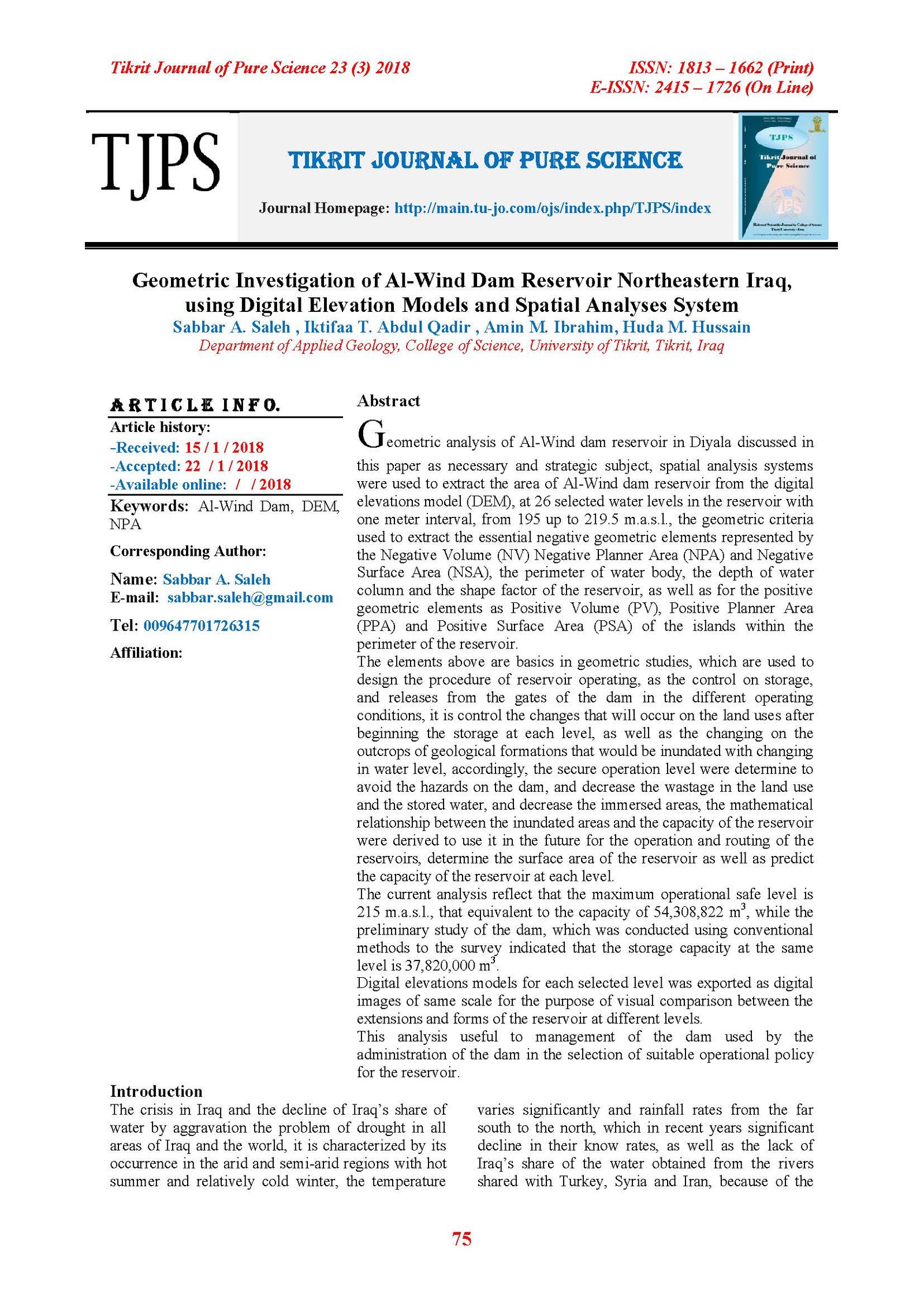Geometric Investigation of Al-Wind Dam Reservoir Northeastern Iraq, using Digital Elevation Models and Spatial Analyses System
Main Article Content
Abstract
Geometric analysis of Al-Wind dam reservoir in Diyala discussed in this paper as necessary and strategic subject, spatial analysis systems were used to extract the area of Al-Wind dam reservoir from the digital elevations model (DEM), at 26 selected water levels in the reservoir with one meter interval, from 195 up to 219.5 m.a.s.l., the geometric criteria used to extract the essential negative geometric elements represented by the Negative Volume (NV) Negative Planner Area (NPA) and Negative Surface Area (NSA), the perimeter of water body, the depth of water column and the shape factor of the reservoir, as well as for the positive geometric elements as Positive Volume (PV), Positive Planner Area (PPA) and Positive Surface Area (PSA) of the islands within the perimeter of the reservoir.
The elements above are basics in geometric studies, which are used to design the procedure of reservoir operating, as the control on storage, and releases from the gates of the dam in the different operating conditions, it is control the changes that will occur on the land uses after beginning the storage at each level, as well as the changing on the outcrops of geological formations that would be inundated with changing in water level, accordingly, the secure operation level were determine to avoid the hazards on the dam, and decrease the wastage in the land use and the stored water, and decrease the immersed areas, the mathematical relationship between the inundated areas and the capacity of the reservoir were derived to use it in the future for the operation and routing of the reservoirs, determine the surface area of the reservoir as well as predict the capacity of the reservoir at each level.
The current analysis reflect that the maximum operational safe level is 215 m.a.s.l., that equivalent to the capacity of 54,308,822 m3, while the preliminary study of the dam, which was conducted using conventional methods to the survey indicated that the storage capacity at the same level is 37,820,000 m3.
Digital elevations models for each selected level was exported as digital images of same scale for the purpose of visual comparison between the extensions and forms of the reservoir at different levels.
This analysis useful to management of the dam used by the administration of the dam in the selection of suitable operational policy for the reservoir.
Article Details

This work is licensed under a Creative Commons Attribution 4.0 International License.
Tikrit Journal of Pure Science is licensed under the Creative Commons Attribution 4.0 International License, which allows users to copy, create extracts, abstracts, and new works from the article, alter and revise the article, and make commercial use of the article (including reuse and/or resale of the article by commercial entities), provided the user gives appropriate credit (with a link to the formal publication through the relevant DOI), provides a link to the license, indicates if changes were made, and the licensor is not represented as endorsing the use made of the work. The authors hold the copyright for their published work on the Tikrit J. Pure Sci. website, while Tikrit J. Pure Sci. is responsible for appreciate citation of their work, which is released under CC-BY-4.0, enabling the unrestricted use, distribution, and reproduction of an article in any medium, provided that the original work is properly cited.
References
1. Al-Kraeay, N. A., Al-Jubory, A. j., and Al-Qaisy, M. Q., (2016). Geometric Analysis of the Location of Al-Jirnaf Suggested Dam, Al-Shirqat/ North Iraq, Tikrit Journal for Pure Science, Vol. 21, no. 2, pp. 112-135.
2. Haghiabi, A.H., Slamian, S.S., Mohammadzadeh-Habili, J. and Mosavi, S.F., (2013). Derivation of reservoir's area- capacity equations based on the shape factor, IJST, Transactions of Civil Engineering, Iran, Vol. 37,No.C1.
3. Laurence, C., (2007). Effect of landslides on dam and reservoir, Mokihinui Dam, Opus International Consultants Limited, internal technical, Wellington, New Zealand
4. Ministry of water resources, AlRafidain General Company for Dams Design and Construction, (2010). Al-Wind dam Project, Internal report,
5. Saleh, S. A., and Al-Shahry, G. Sh., (2017). Flood Routing of Tigris River in Baiji Station and Makhoul Dam Reservoir under Supposed Operation of the Dam, Tikrit Journal for Pure Science, Vol. 22, no. 1, pp. 115-127.
6. Salih, L. M., (2013), Makhoul dam reservoir, Hydrologic and geometric study to select the optimum levels, unpublished Ph. D. thesis, Department of Geography. College of education for Humanities, Tikrit University.
7. Sawunyama, T., Senzanje A., Mhizha, A., (2005). Estimation of small reservoir storage capacities Limpopo river basin using geographical information system and remote sensed surface areas, M.Sc. thesis, department of civil engineering, faculty of engineering, university of Zimbabwe.
